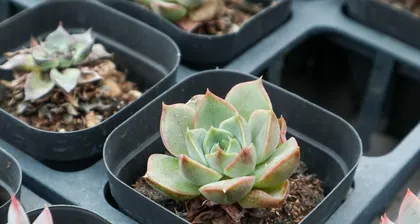In recent years, succulent plants have become one of the most popular houseplants for many people. However, there are also many who worry about whether the toxic components in succulents can harm human health or if they are suitable for indoor cultivation. Today we will delve into these issues.

What are the toxic components in succulent plants?
The toxic components in succulent plants are generally toxins and medicinal ingredients. Among them, bitter acid and fluorine are relatively common. Bitter acid is usually found in agave and cactus succulents, which can cause skin stinging and indigestion; Fluorine is mainly present in agave and can damage the nervous system.
What are the hazards of toxic components in succulent plants to humans?
The degree of hazard posed by the toxic components in succulent plants varies. Generally speaking, contact with the skin may cause reactions such as stinging and redness. If succulents containing toxic components are accidentally ingested or come into contact with mucous membranes like the eyes, severe poisoning symptoms can occur, even leading to life-threatening danger.

Which groups of people need to pay attention to the toxic components of succulent plants?
Since the toxic components in succulent plants pose a significant risk to human health, certain groups need to be particularly cautious, such as pregnant women, children, and the elderly. For these individuals, it's best to avoid direct contact with succulents, let alone accidental ingestion or placing succulents containing toxic components indoors.
Is it safe to cultivate succulent plants indoors?
Cultivating succulent plants indoors is relatively safe, but some details need to be noted, such as ensuring good ventilation, preventing overwatering, and avoiding direct sunlight. At the same time, when cultivating succulents indoors, it's best to choose varieties without toxic components to avoid harming human health.
How to properly care for succulent plants?
Proper care methods can make succulent plants grow healthier and more beautiful, while also reducing the chance of the plant releasing toxic components. Proper care includes maintaining ventilation, regular watering, avoiding excessive sun exposure, and timely pest control.

What problems need to be paid attention to when cultivating succulent plants indoors?
When cultivating succulents indoors, the main points to note include avoiding overwatering, maintaining ventilation, and avoiding direct sunlight. Additionally, if there are children or pets at home, special attention should be paid to the selection and placement of succulents.
What are the propagation methods for succulent plants?
The main propagation methods for succulent plants are cuttings and division. Cuttings involve inserting leaves or stems of succulents into soil for reproduction, while division involves separating the original succulent plant into several parts for propagation.
How to choose succulent plants suitable for indoor cultivation?
When choosing succulents suitable for indoor cultivation, you need to consider the plant's environmental requirements and adaptability. Generally, it's better to choose succulents that prefer shade and don't require much sunlight, and it's best to select varieties without toxic components.
What issues need to be considered when placing succulent plants indoors?
When placing succulents indoors, the main issues to consider include maintaining ventilation, avoiding direct sunlight, and avoiding placing them in easily bumped areas. If there are children or pets at home, attention should also be paid to the selection and placement of succulents.
What are the benefits of cultivating succulent plants indoors?
Cultivating succulents indoors can increase indoor air humidity, purify the air, and relieve visual fatigue. At the same time, succulent plants can also provide an aesthetically pleasing and comfortable decorative effect, allowing people to feel the breath of nature in their daily lives.
Why do succulent plant leaves fall off?
Succulent plant leaf drop is usually caused by reasons such as overwatering, excessive fertilization, or lack of sunlight. In this case, it is necessary to adjust the care method promptly to prevent further damage to the plant.
What are the methods for preventing and controlling pests and diseases in succulent plants?
The main pests and diseases of succulents include whiteflies, spider mites, etc. Prevention and control methods mainly include paying attention to ventilation, timely pest removal, and using appropriate pesticides.
Do succulent plants need regular pruning?
Succulent plants need regular pruning, mainly to maintain the plant's tidiness and aesthetic shape, and also to promote growth and renewal.
What should be noted when repotting succulent plants?
When repotting, it is important to choose suitable soil and pots, and be careful not to damage the roots or allow them to stretch excessively, otherwise it will affect the plant's growth and health.
Cultivating succulent plants indoors is relatively safe, but attention must also be paid to some toxic components and details. Proper care methods can make succulent plants grow healthier and more beautiful, while also reducing the chance of the plant releasing toxic components. Let's work together to create a beautiful world of succulents!